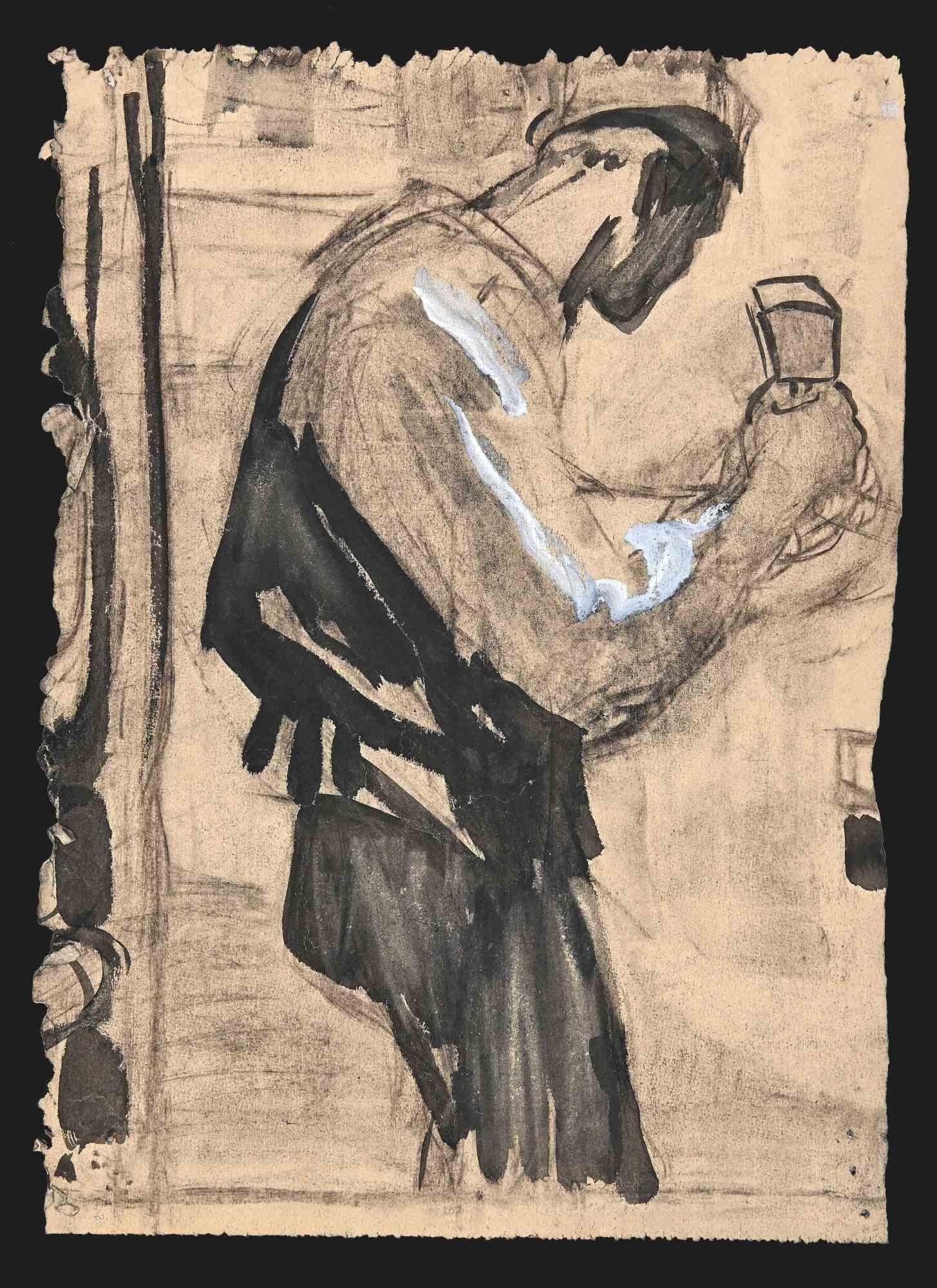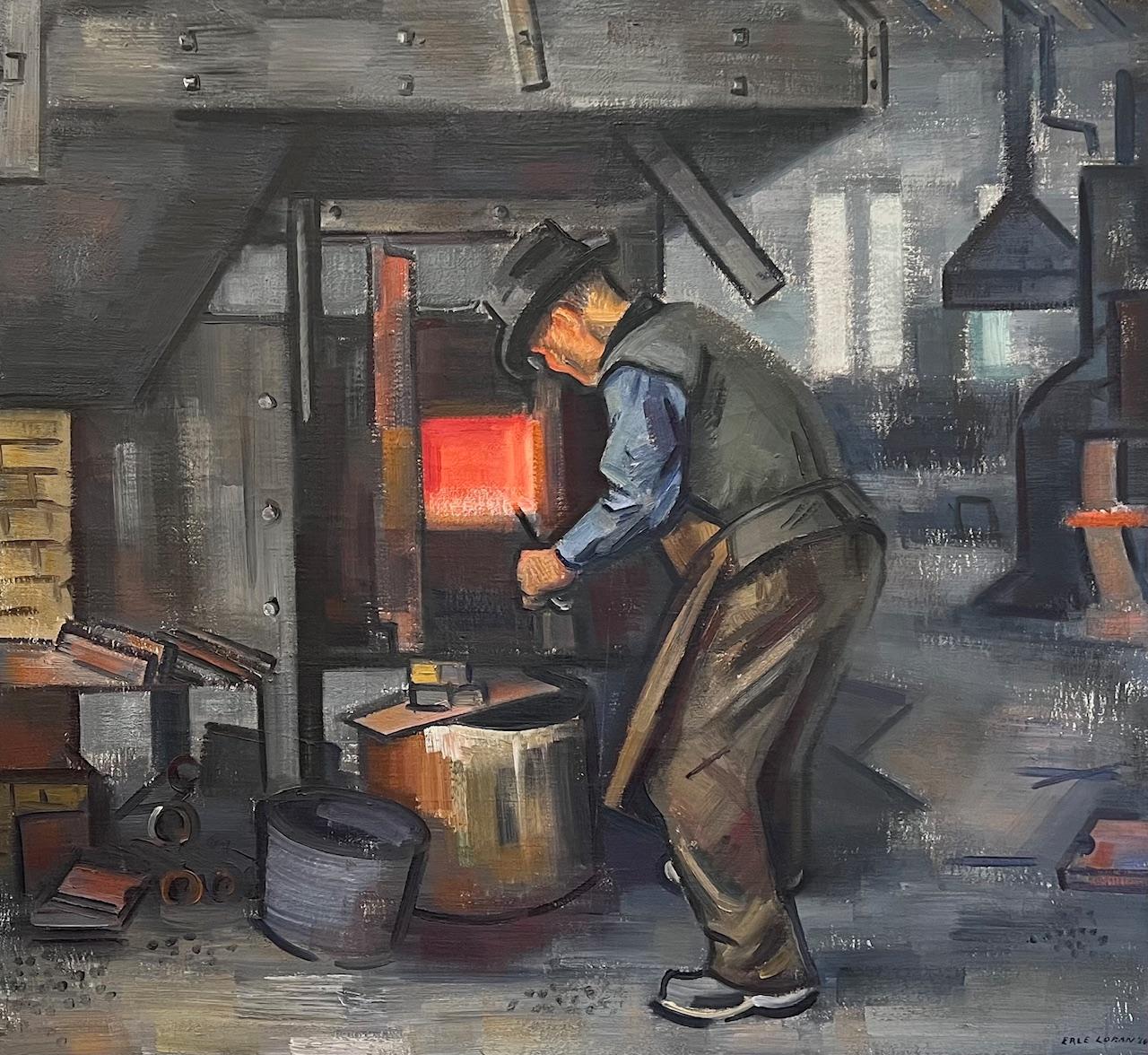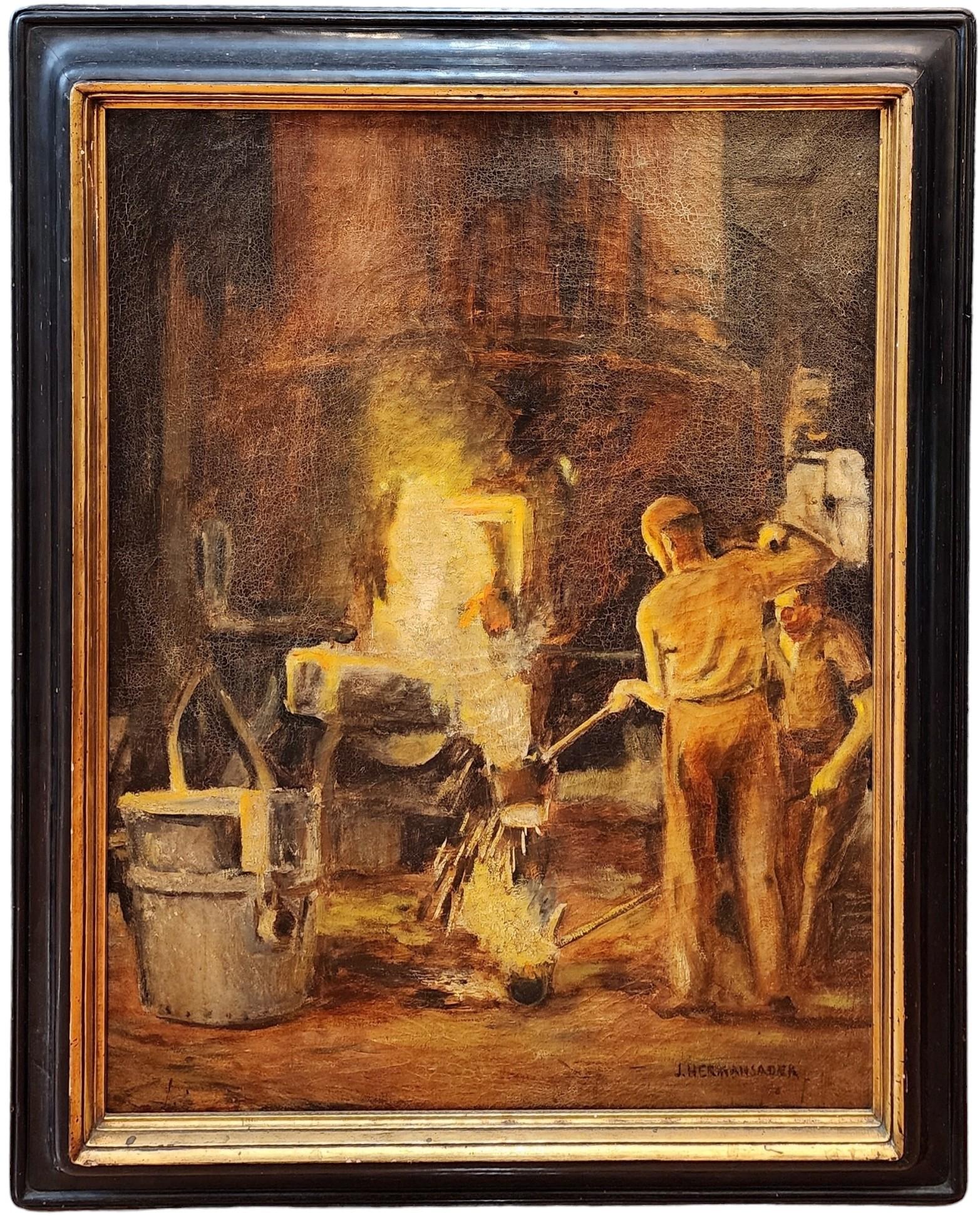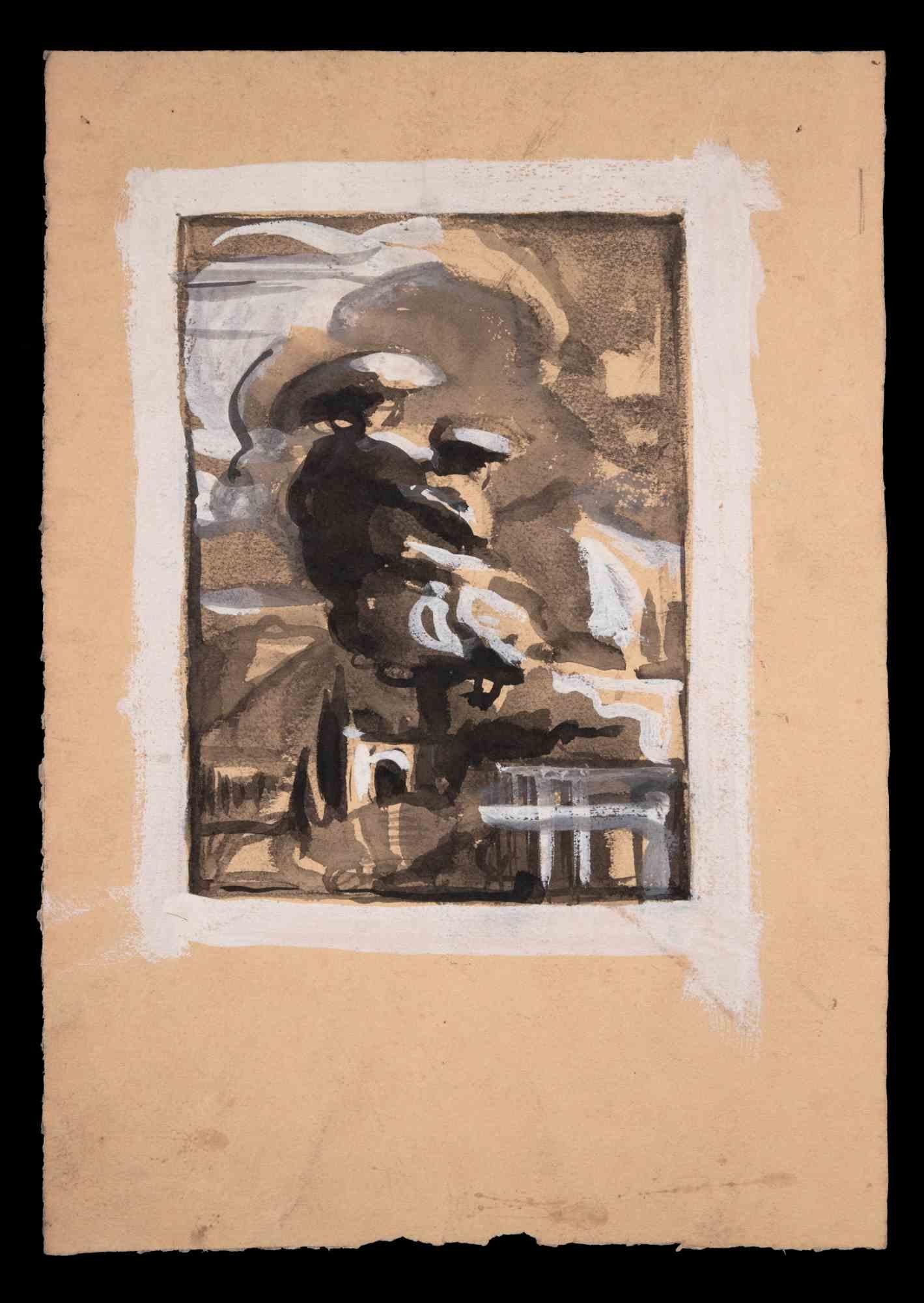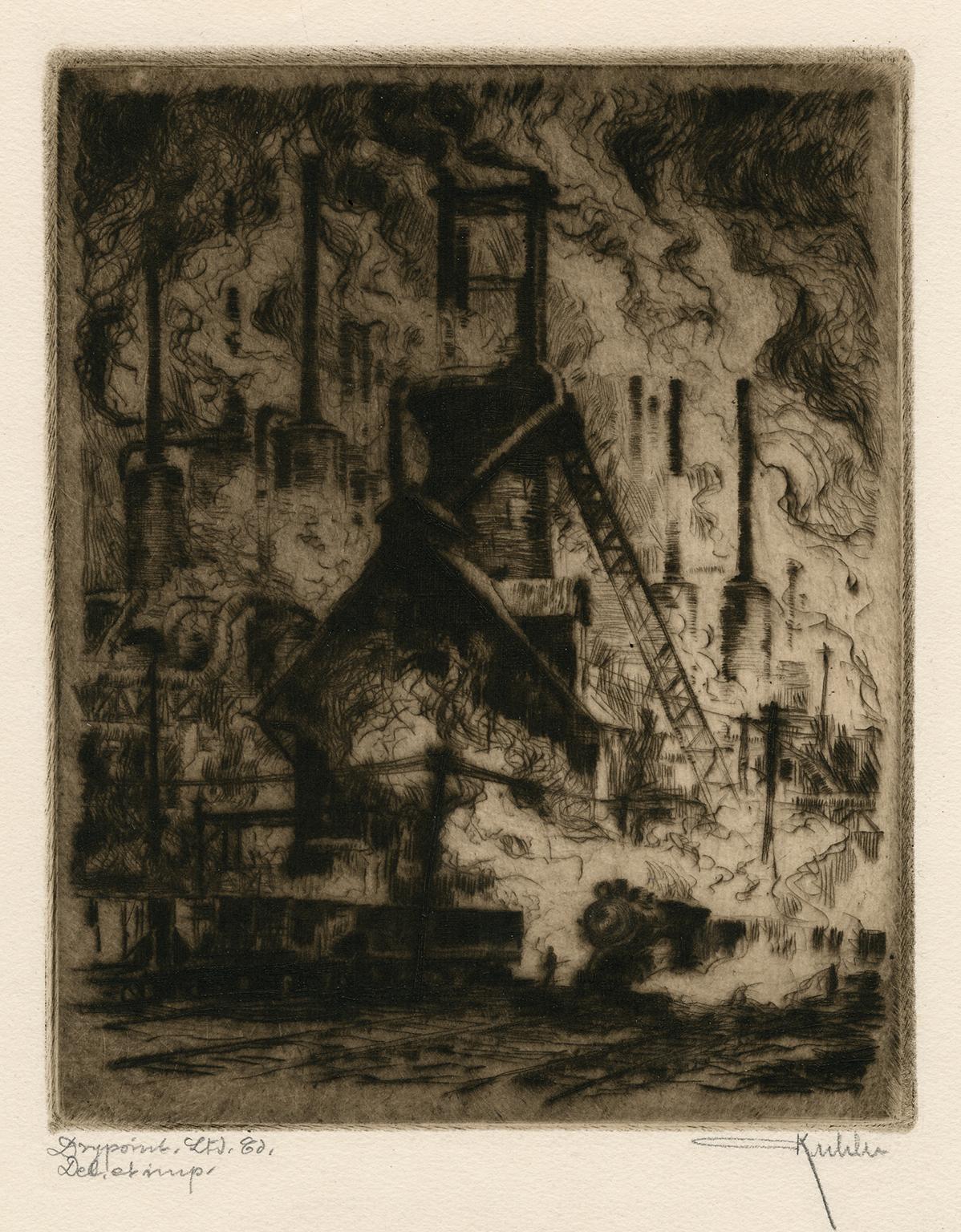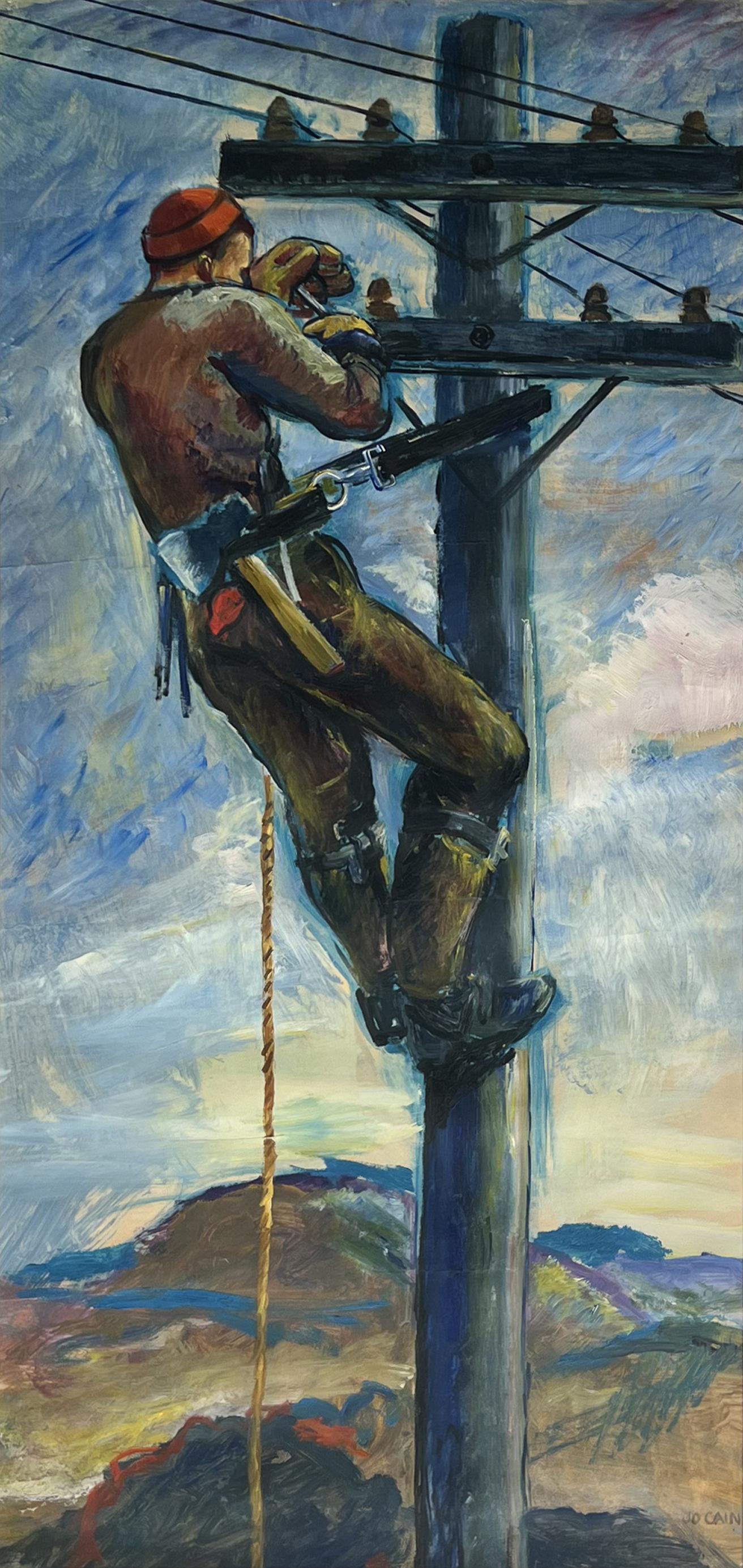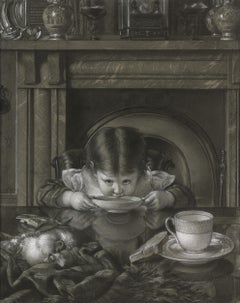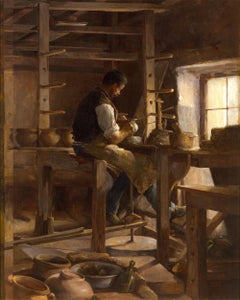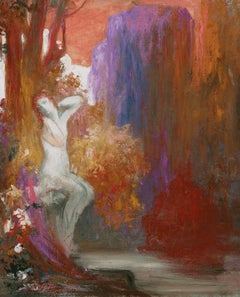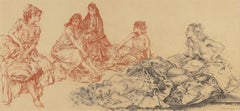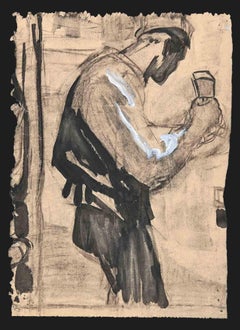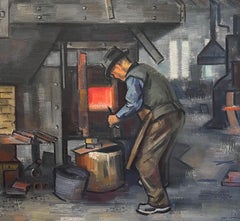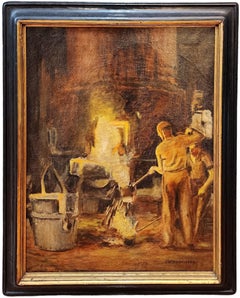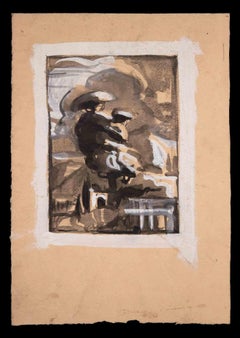Items Similar to Le Fondeur De Bronze By Lucien Lévy-Dhurmer
Want more images or videos?
Request additional images or videos from the seller
1 of 8
Lucien Levy-DhurmerLe Fondeur De Bronze By Lucien Lévy-DhurmerCirca 1906-1907
Circa 1906-1907
$88,500
£67,222.99
€77,463.67
CA$124,629.92
A$138,170.69
CHF 72,614.09
MX$1,690,982.68
NOK 906,876.16
SEK 851,194.01
DKK 578,218.17
About the Item
Lucien Lévy-Dhurmer
1865-1953 French
Le fondeur de bronze
Signed "Levy Dhurmer" (lower right)
Pastel on paper
French painter Lucien Lévy-Dhurmer was one of the leading artists of the Symbolist and Art Nouveau movements at the turn of the century. This compelling portrait of men working in a bronze foundry bears witness to the artist’s skill for infusing his compositions with poignant imagery that honors the lives and labor of everyday people. Through a brilliant use of color and perspective, Lévy-Dhurmer's Le fondeur de bronze immerses the viewer in the intense heat of the foundry.
Lévy-Dhurmer's Le fondeur de bronze is further distinguished by prestigious provenance. The artwork's initial owner was Joseph Malesset, a French industrialist who made his fortune in owning industrial factories, including bronze foundries. Malesset was promoted to the revered grade of Officer of the Legion of Honor, the highest French order of merit, in 1906, and Lévy-Dhurmer's painting was created to glorify the visionary's achievements.
Born in French Algeria in 1865, Lucien Lévy-Dhurmer studied drawing and sculpture in Paris as a child and began his artistic career as a decorative painter at a porcelain manufactory in Golfe-Juan. Throughout his long career, Lévy-Dhurmer experimented with different artistic styles and mediums, succeeding as a ceramicist, painter, pastelist, and furniture designer. Perhaps his most celebrated work, the famed Wisteria Dining Room, now held in the Metropolitan Museum of Art, is a brilliant example of the artist’s remarkable range of skills in various media.
It was his trip to Italy in 1895 that would change the course of his life and interests. It was there that he discovered an interest in German and Florentine Renaissance — resulting in paintings that fit in well alongside those of the English Pre-Raphaelites. That same year, Lévy-Dhurmer officially began his painting career. In 1896, he held his first solo exhibition at the Galerie Georges Petit in Paris, where he appeared for the first time under the name Lévy-Dhurmer, adding to his surname Lévy part of his mother's maiden name, Pauline-Amelie Goldhurmer.
His unique blend of Academic detail with Impressionist color and technique garnered the artist considerable attention. He was drawn to the ideals of the Symbolist movement, which offered an intellectual alternative to the purely visual ideals of the Impressionists. Rather, the subject matter of the Symbolists explored more complex emotional and spiritual ideas - this highly personal portrait is a remarkable example of the movement's ethos.
Circa 1906-1907
Bears label on mount "Le fondeur de bronze / par Levy Dhurmer/ offert par ses amis à Monsieur J. MALESSET / Président de Section au Tribunal de Commerce de la Seine / à l'occasion de / Sa Nomination d'OFFICIER de la LEGION d'HONNEUR/10 février 1907"
Canvas: 34 3/4" high x 24" wide
Frame: 42 3/4" high x 33 3/8" wide x 2 1/2" deep
Provenance:Private Collection of Joseph Malesset
Private Collection, by descent from above
Private Collection, Basel, Switzerland
M.S. Rau, New Orleans
- Creator:Lucien Levy-Dhurmer (1865-1953, French)
- Creation Year:Circa 1906-1907
- Dimensions:Height: 42.75 in (108.59 cm)Width: 33.38 in (84.79 cm)Depth: 2.5 in (6.35 cm)
- Medium:
- Movement & Style:
- Period:
- Condition:
- Gallery Location:New Orleans, LA
- Reference Number:Seller: 31-68721stDibs: LU18612354972
About the Seller
5.0
Vetted Professional Seller
Every seller passes strict standards for authenticity and reliability
Established in 1912
1stDibs seller since 2013
18 sales on 1stDibs
Typical response time: 10 hours
- ShippingRetrieving quote...Shipping from: New Orleans, LA
- Return Policy
Authenticity Guarantee
In the unlikely event there’s an issue with an item’s authenticity, contact us within 1 year for a full refund. DetailsMoney-Back Guarantee
If your item is not as described, is damaged in transit, or does not arrive, contact us within 7 days for a full refund. Details24-Hour Cancellation
You have a 24-hour grace period in which to reconsider your purchase, with no questions asked.Vetted Professional Sellers
Our world-class sellers must adhere to strict standards for service and quality, maintaining the integrity of our listings.Price-Match Guarantee
If you find that a seller listed the same item for a lower price elsewhere, we’ll match it.Trusted Global Delivery
Our best-in-class carrier network provides specialized shipping options worldwide, including custom delivery.More From This Seller
View AllL’Heure du goûter! by Jules-Émile Saintin
Located in New Orleans, LA
Jules-Émile Saintin
1829-1894 French
L’Heure du goûter!
(Snack Time!)
Signed "Jules-Émile Saintin" (lower right)
Charcoal and white chalk on paper
A tender moment unfolds as a young girl leans over her bowl of soup, savoring her midday snack with focus and delight. Her spoon rests beside a slice of bread on the polished tabletop, while a cup, perhaps filled with tea or chocolate, and a second piece of bread complete the simple yet cozy scene. Nearby, her stuffed toy lies temporarily forgotten atop a shawl, hinting at the world of play just briefly paused.
The setting is intricately detailed. The dining room showcases a marble fireplace adorned with a clock, fine porcelain and delicate cups. Saintin’s composition captures the quiet grace of the moment as well as the interplay of light and texture, skillfully rendered using only charcoal and white chalk. His ability to infuse luminosity into a monochrome drawing speaks to his refined technique and observational sensitivity. This work resonates with Saintin’s charming studies of children during his American period, such as A Little Girl Dozing Over Her Drawing (possibly a portrait of Jennie Walters), now in the Walters Art Museum in Baltimore.
Born in 1829 in Lemé, Saintin began painting at age 11 and was admitted to the Académie des Beaux-Arts in Paris by 16. Trained under Martin Drölling and Édouard Picot, he became an accomplished portraitist and debuted at the Salon des Artistes Français in 1848, earning several medals.
In 1853, he moved to New York to work in a photography studio, soon dedicating himself fully to painting. He exhibited regularly at the National Academy of Design—becoming a member in 1858—and gained a strong reputation for his portraits of American elites, as well as for his depictions of landscapes and Native American clothing...
Category
19th Century Figurative Drawings and Watercolors
Materials
Paper, Chalk, Charcoal
The Potter
Located in New Orleans, LA
Léon Olivié-Bon
1863-1901 French
The Potter
Oil on canvas
Signed and dated "Olivie-Bon 1888" (lower right)
This monumental masterpiece by French artist Léon Olivié-Bon is one of ...
Category
19th Century Academic Figurative Paintings
Materials
Canvas, Oil
$124,500
Ondine
By Pierre Marcel-Béronneau
Located in New Orleans, LA
Mystical and mysterious, a mythological Ondine rests beside an ethereal forest pond in this majestic, original oil on canvas by French Symbolist Pierre-Amédée Marcel-Béronneau. A stu...
Category
20th Century Symbolist Nude Paintings
Materials
Canvas, Oil
A Study of Two Models by Sir William Russell Flint
By William Russell Flint
Located in New Orleans, LA
Sir William Russell Flint, R.A., P.R.W.S.1880-1969 Scottish
A Study of Two Models
Signed "WRussell Flint" (bottom right)
Ethereal and sen...
Category
20th Century Figurative Drawings and Watercolors
Materials
Paper, Chalk
Fisher Boy by Marcel Début
By Marcel Debut
Located in New Orleans, LA
Marcel Début
1865–1933 French
Fisher Boy
Signed "Marcel Début" on base
Patinated bronze
A rare and visually dynamic example of late 19th-century French bronze sculpture, Fisher B...
Category
Late 19th Century Figurative Sculptures
Materials
Bronze
Danseuse By Pierre Carrier-Belleuse
By Pierre Carrier-Belleuse
Located in New Orleans, LA
Pierre Carrier-Belleuse
1851-1932 French
Danseuse
Signed “Pierre Carrier-Belleuse” (lower right)
Pastel on canvas
Strikingly elegant, this extraordinary pastel by French impressi...
Category
19th Century Impressionist Figurative Drawings and Watercolors
Materials
Canvas, Pastel
You May Also Like
The Smith - Drawing - Early 20th Century
Located in Roma, IT
The Smith is an original drawing in pencil and watercolor realized by Rémy Hetreau in the mid-20th Century.
In good conditions.
The artwork is presented through expressive and deft...
Category
Early 20th Century Modern Figurative Drawings and Watercolors
Materials
Watercolor, Pencil
Blacksmith (Untitled)
By Erle Loran
Located in Los Angeles, CA
Blacksmith (Untitled), 1936, oil on canvas, signed and dated lower right, 28 x 30 inches
Erle Loran was an influential American painter, art historian, and educator, renowned for h...
Category
1930s American Modern Figurative Paintings
Materials
Canvas, Oil
Steelworkers, Men Working, American Work Force, Jazz Enthusiast
Located in Grand Rapids, MI
John Hermansader (American, 1915 - 2005)
Signed: J. Hermansader (Lower, Right)
Steelworkers, c. 1940s
Oil on Canvas
30" x 24"
Housed in a 3" Frame
Overall Size: 35 1/2" x 29 1/4"
Craquelure throughout. In otherwise good condition.
Biography:
John Hermansader (1915–2005) was an American painter, graphic designer, and jazz fan. He is remembered for his iconic designs of Blue Note record covers.
John Bancroft Hermansader was born on November 1, 1915 near Reading, Pennsylvania. In the 1930s, he studied at the Memphis Academy of Art in Tennessee and the New Bauhaus in Chicago, Illinois. In New York City he studied with Robert Motherwell at the New School of Social Research.
In 1939, he and his wife Rosemary were founders of the Hot Club of Newark, New Jersey, a significant group of jazz enthusiasts. John became the first president.
In 1951, when Blue Note Records began issuing 10 inch records, Hermansader was one of their first designers, along with Paul Bacon and Gil Melle. Looking back at this era, Michael Cuscuna of Mosaic Records said, “ What John Hermansader and Paul Bacon really did was evoke the feeling of the music. They used everything from Bauhaus designs to things that were really otherworldly.” Angelynn Grant adds, “When people think of Blue Note covers they think of Frank Wolff”s photography and Reid Miles design. But John Hermansader laid the groundwork that got them going along that path.” Richard Cook, who wrote Blue Note Records: The Biography states, “Hermansader in particular balanced the twin issues of photography and type in a way that would mirror the concerns of the Blue Note of the years ahead.”
“John Hermansader was passionate about oil painting, “beautiful lyrical abstractions, full of color and movement.” He was an abstract expressionist painter who drew inspiration for his work from listening to jazz.” - (Obituary, Pilot, Redding Conn., July 14, 2005, p. 32A)
His exhibitions included and the Gallery of Contemporary Art at Sunken Meadow, Long Island, 1951–58, Panoras Gallery 1956...
Category
Mid-20th Century Paintings
Materials
Canvas, Oil
$1,158 Sale Price
40% Off
Composition - Original Painting by Claude Guez - Mid-20th Century
By Claude Guez
Located in Roma, IT
Composition is an Original Tempera realized by Claude Guez in the early 20th century.
The artwork is in good condition on a yellowed cardboard.
No signa...
Category
Mid-20th Century Modern Figurative Drawings and Watercolors
Materials
Tempera
'The Furnace' — American Expressionism
By Otto Kuhler
Located in Myrtle Beach, SC
Otto Kuhler, 'The Furnace', drypoint, edition 26, 1924, Kennedy 5. Signed and annotated 'Drypoint. Ltd Ed. Del. et imp.' in pencil. Titled in pencil, in the bottom center sheet edge....
Category
1920s American Modern Figurative Prints
Materials
Drypoint
Man Working Mid 20th Century American Scene Social Realism Industrial WPA Modern
By Jo Cain
Located in New York, NY
Man Working Mid 20th Century American Scene Social Realism Industrial WPA Modern
Jo Cain (1904 - 2003)
Telephone Pole Worker
38 1/4 x 18 1/2 inches
Oil on pap...
Category
1930s American Realist Figurative Drawings and Watercolors
Materials
Paper, Gouache
More Ways To Browse
Antique Drawing Room Furniture
Painting Antique Dining Room Furniture
Art By Lucien
English Renaissance Painting
George Post Watercolor Paintings
George Post Watercolor
Bronze Mother And Child
German Pastel Portrait
Initials S J
J M Antiques
Wisteria Art
Art Nouveau Maiden
1895 Porcelain
J Levy
Wisteria Painting
Rau Antique
Italian Florentine Porcelain
Lucien Dhurmer Levy
